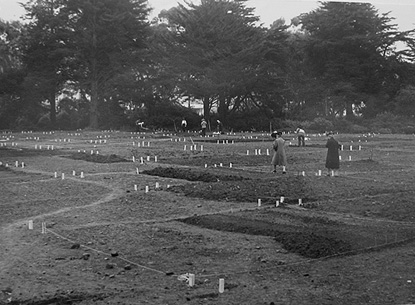Victory Gardens, also called "war gardens" or "food gardens for defense", were gardens planted both at private residences and on public land during World War I and World War II to reduce the pressure on the public food supply brought on by the war effort. In addition to indirectly aiding the war effort these gardens were also considered a civil "morale booster" — in that gardeners could feel empowered by their contribution of labor and rewarded by the produce grown. These gardens produced up to 41 percent of all the vegetable produce that was consumed in the nation.
-City Bountiful: A Century of Community Gardening in America, Laura Lawson In 1941, America went to war. At home the war effort touched everyone. Throughout the country, at home in the States, people plowed front yards, lawns, back yards, flower gardens and vacant lots to grow their own vegetables. Even public land was put to use, from the lawn at San Francisco City Hall to the Boston Commons to portions of San Francisco's Golden Gate Park. San Francisco's victory program became one of the best in the country. There were over 800 gardens in Golden Gate Park. Every park in the city had gardens and many vacant lots were used for growing vegetables. Drawing from the rich history of World War II Victory Gardens, Victory Gardens 2007+ puts a new spin on the meaning of “victory”. In this program, “victory” is:
- independence from corporate food systems
- community involvement
- getting people closer to the natural environment.  | | 1943 Golden Gate Park. Over 200 gardens. |
 |